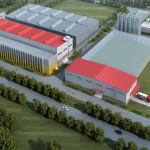 Specialty chemicals company LANXESS is strengthening its presence in the growth market China: The Cologne-based company is building a new plant for high-performance plastics in Changzhou for around EUR 20 million. From Q2 2019, the compounding plant is to produce up to 25,000 metric tons of Durethan- and Pocan-branded high-tech plastics for the automotive sector and the electric and electronics industry.
Specialty chemicals company LANXESS is strengthening its presence in the growth market China: The Cologne-based company is building a new plant for high-performance plastics in Changzhou for around EUR 20 million. From Q2 2019, the compounding plant is to produce up to 25,000 metric tons of Durethan- and Pocan-branded high-tech plastics for the automotive sector and the electric and electronics industry.China is the largest automotive market in the world and is setting the pace for electromobility. We want to support growth in this important region and are expanding our presence in the high-performance plastic segment,” said Matthias Zachert, Chairman of the LANXESS Board of Management, at a press conference in Shanghai. LANXESS already operates a plant for high-performance plastics in Wuxi, China.
According to studies, around one in four of the approximately 85 million cars sold around the world this year will be sold in China. This figure is expected be one in three in 2025. The electric and electronics industry also offers a great deal of potential in China. LANXESS expects here annual growth of around nine percent till 2021.
“At the same time, we are expanding our global network of compounding plants with the new production site and are continuing to consistently focus our portfolio on high-value plastics,” said Michael Zobel, Head of the High Performance Materials business unit at LANXESS.
Changzhou site to be strengthened
With the investment LANXESS is also significantly strengthening the Changzhou site. At the Binjiang Chemical Park in Changzhou, the Group already has plants for leather chemicals and synthetic rubber, which currently employ around 350 people. The new plant for high-performance plastics will create 35 additional jobs.Lightweight solutions for modern mobility
The automotive industry is the most important customer for LANXESS’ high-performance plastics. The innovative materials allow the construction of components to replace metal parts in motor vehicles and thus contribute to reducing weight, fuel consumption and emissions. LANXESS plastics are used, for example, in engine applications, door structures, pedals, front ends and cockpit cross members. Depending on the part, the lightweight construction can make a weight-saving of up to 50 percent.There are also many applications for LANXESS plastics in hybrid and electric vehicles, some of which are already successful in mass production. These include components for charging systems, carriers and cell holders for battery systems as well as sensors and housing parts for electric motors. The materials also have great potential in electromobility infrastructure, such as in housing, switches and terminal clips for charging stations. In autonomous driving, polyamides and polyesters are ideal for connectors for sensors, displays and control units, for example
Global production network
The business unit operates a global production network at the following locations: Dormagen (Research & Development); Krefeld-Uerdingen (PA 6 Polymerization, Compounding); Hamm-Uentrop (PBT Polymerization, Compounding); Brilon (Tepex Production and Development); Antwerp, Belgium (PA 6 Polymerization); Wuxi, China (Compounding); Jhagadia, India (Compounding); Gastonia, USA (Compounding); and Porto Feliz, Brazil (Compounding).Source: LANXESS



